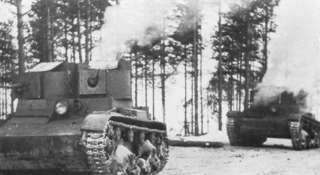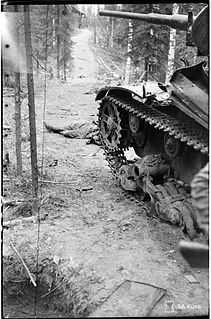History
During the mobilization prior to the Winter War, the 6th Division was placed in the reserve of the Commander-in-Chief Gustaf Mannerheim. The division consisted of reservists mainly from Satakunta. On 19 December it was attached to the II Corps. The 6th and 1st Divisions were to attack the advancing Soviet forces near Summa. The attack began on 23 December but was a failure.

Mobilization, in military terminology, is the act of assembling and readying troops and supplies for war. The word mobilization was first used, in a military context, to describe the preparation of the Imperial Russian Army during the 1850s and 1860s. Mobilization theories and tactics have continuously changed since then. The opposite of mobilization is demobilization.

Baron Carl Gustaf Emil Mannerheim was a Finnish military leader and statesman. Mannerheim served as the military leader of the Whites in the Finnish Civil War, Regent of Finland (1918–1919), commander-in-chief of Finland's defence forces during World War II, Marshal of Finland, and the sixth president of Finland (1944–1946).
The II Corps was a unit of the Finnish Army during the Winter War.
In the beginning of January 1940, the division's name was changed to the 3rd Division. This was done in order to confuse the enemy, but it is uncertain if this had any effect.
In January 1940 the division replaced the 5th Division at the Summa front.
The 5th Division was a unit of the Finnish Army during the Winter War. It was part of the II Corps which fought on the Karelian Isthmus as part of the Army of the Isthmus. It was stationed on the Mannerheim Line between Lake Muolaanjärvi and Kuolemajärvi.
In February the Soviet forces began bombarding the front lines at Summa with artillery fire. On the morning of 11 February, the attack began along the whole front of the exhausted 3rd Division. The Soviets had concentrated nine divisions and five armoured brigades of the 7th Army at Summa. The Finnish lines broke on 13 February and the forces retreated to the Intermediate Line (Väliasema).

The Soviet Red Army's 7th Army first saw action in the 1939–40 Winter War against Finland. In November 1939, just before the initial Soviet attack, it consisted of the 19th Rifle Corps, 50th Rifle Corps, 10th Tank Corps, 138th Rifle Division, and an independent tank brigade. The Army was first under Commander Yakovlev, but he was removed from command of his army and returned to Leningrad. Command of the war operation Kirill Meretskov was called-off due to extensive failures and heavy casualties, and he replaced Yakovlev as the commander of the Seventh Army.

The Battle of Tolvajärvi was fought on 12 December 1939 between Finland and the Soviet Union. It was the first large offensive victory for the Finns in the Winter War.
The IV Corps was a formation of the Finnish Army during the Winter War against the Soviet Union. It defended the area north of Lake Ladoga against Soviet attacks. It was commanded by Major General Juho Heiskanen and from 4 December 1939 by Major General Woldemar Hägglund. The IV Corps defeated superior Soviet troops by using motti tactics.
The 44th Infantry Division was formed on 1 April 1938 in Vienna, about two weeks after the Anschluss of Austria. It first saw combat at the start of the war in the Invasion of Poland, and also took part in the Battle of France in 1940. After a 9-month period of coastal defence the division was transferred East. On 22 June 1941, the division took part in the invasion of the Soviet Union, attached to Army Group South. It remained in the east after the failure of "Operation Barbarossa", taking part in defensive actions for the winter against the Soviet Army offensives near Izum and Karkov. Refurbished, the division participated in the German summer offensive, and was subsequently destroyed with the 6th Army at Stalingrad in January 1943.

The Battle of Ilomantsi was a part of the Svir–Petrozavodsk Offensive of the Continuation War (1941–1944). It was fought from July 26 to August 13, 1944, between Finland and the Soviet Union in an area roughly 40 kilometers wide and 30 kilometers deep, near the Finnish-Soviet border, close to the small Finnish town of Ilomantsi, in North Karelia. The battle ended with a Finnish victory—the last major Soviet attack against Finland was stopped here.

The Battle of Vyborg Bay was fought in the Finnish-Soviet Continuation War (1941–1944).
5. Division was a Finnish Army division in the Continuation War. The division was formed by Etelä-Häme military province from the men in Kanta-Häme and Lounais-Häme civil guard districts.
The 1st Division was one of the three Estonian divisions created during the Estonian War of Independence, which was active till the Soviet occupation of Estonia. Since the restoration of independence in 1991 there are no divisions currently among the Estonian Defence Forces.

The 44th Kievskaya of the Red Banner Rifle Division of Nikolay Shchors, or 44th Kievskaya for short, was an elite military formation of the Soviet Union.

The Battle of Tali-Ihantala was part of the Finnish-Soviet Continuation War (1941–1944), which occurred during World War II. The battle was fought between Finnish forces—using war materiel provided by Germany—and Soviet forces. To date, it is the largest battle in the history of the Nordic countries.
The 17th Rifle Division was an infantry division of the Soviet Union's Red Army during World War II.
The 42nd Army was a field army of the Soviet Union's Red Army, created in 1941.
The 42nd Rifle Division was a unit of the Red Army during the Great Patriotic War. The division, first formed in 1940, was nearly destroyed in the opening days of the Operation Barbarossa defending the Brest Fortress. Disbanded in late December 1941 and immediately reformed in the Volga Military District. The division then served on the front until disbanded at the end of the war.

The German 215th Infantry Division (215.Infanterie-Division) was a major military unit of the German Army that served in World War II.
The 119th Rifle Division was an infantry division of the Red Army, formed three times.
The 142nd Rifle Division began service in August, 1939 as a standard Red Army rifle division, which participated in the Winter War against Finland. It remained on the Karelian Isthmus and had a relatively uneventful war facing the Finns until the Vyborg–Petrozavodsk Offensive began on June 10, 1944, from which point it saw much more active service. Following the end of the Continuation War, the division was transferred to 2nd Shock Army in 2nd Belorussian Front. Its soldiers distinguished themselves in the capture of the German city of Graudenz and ended the war fighting through Pomerania.
The 49th Rifle Division was a Soviet Army infantry division, formed three times. First formed as a territorial division in 1931, the 49th Rifle Division's first formation became a regular division by 1939 and fought in the Winter War. For its actions during the war, it was awarded the Order of the Red Banner. However, the 49th Rifle Division was wiped out during the first ten days of Operation Barbarossa. Its second formation occurred in December 1941 and fought at Stalingrad, Kursk, the Vistula-Oder Offensive and the Battle of Berlin. The second formation was disbanded in 1946. The division was reformed in 1955 by renaming the 295th Rifle Division and became the 49th Motor Rifle Division in 1957.
The 54th Rifle Division was an infantry division of the Soviet Union's Red Army and Soviet Army, formed twice. The division was formed in 1936 and fought in the Winter War. The division spent most of World War II in Karelia fighting with Finnish troops in the Continuation War. After Finland left the war the division was relocated southward and fought in the East Prussian Offensive and the Prague Offensive in 1945. The division was disbanded in the summer of that year. The 54th Rifle Division was awarded the Order of Lenin, the Order of the Red Banner and the Order of Kutuzov 2nd class. It was also awarded the honorific "Masuria" for its actions in the East Prussian Offensive. The division was reformed in 1955 from the 341st Rifle Division and became a motor rifle division in 1957.

The 333rd Rifle Division began forming in the North Caucasus Military District in August, 1941, as a standard Red Army rifle division, as part of the massive mobilization of reserve forces very shortly after the German invasion. In 1942 it served in the late winter and early spring fighting near Kharkov, taking a beating both then and during the opening stages of the German summer offensive. Withdrawn into the reserves, the division was rebuilt in time to take part in the Soviet counteroffensive at Stalingrad in November, and played an important role in driving the German forces out of the Caucasus region during the winter. In the autumn of 1943 the division shared credit with the 25th Guards Rifle Division for the liberation of Sinelnikovo in the Dnipropetrovsk Oblast, receiving that place name as an honorific. After battling through Ukraine and into the Balkan states, the 333rd completed its combat path on a relatively quiet note doing garrison duties in the Balkans.

The 358th Rifle Division formed in August 1941, as a standard Red Army rifle division, at Buguruslan. It first saw action in January 1942, taking part in the offensive northwest of Moscow which carved out the salient around Toropets deep in the rear of Army Group Center. The division remained on this general sector of the front, nearly the whole time in 4th Shock Army, until March 1944, when it was withdrawn for rebuilding. It was then assigned to 21st Army north of Leningrad where it participated in the offensive that drove Finland out of the war from June into August, and remained on this front until December. It was then reassigned to the 39th Army, under which it fought in East Prussia until April 1945. During that month the entire 39th Army began moving to the Far East, where it took part in the Soviet invasion of Manchuria in August, where the 358th won its second battle honor, capping a distinguished record of service.

The 21st Guards Rifle Division was an elite infantry division of the Red Army during World War II. It was formed from the 361st Rifle Division on March 17, 1942, in recognition of that division's successes in the attempt to encircle the German 9th Army in the Rzhev area during the Soviet winter counteroffensive of 1941-42. After being partially encircled itself in the spring of 1942, the division was withdrawn for rebuilding, and then played a major role in the Battle of Velikiye Luki in 1942-43. It distinguished itself in the battle for Nevel in October, 1943, for which it was awarded a battle honor. The division went on to complete a combat path through northwestern Russia and into the Baltic States, ending its war containing the German forces trapped in the Courland Peninsula.












